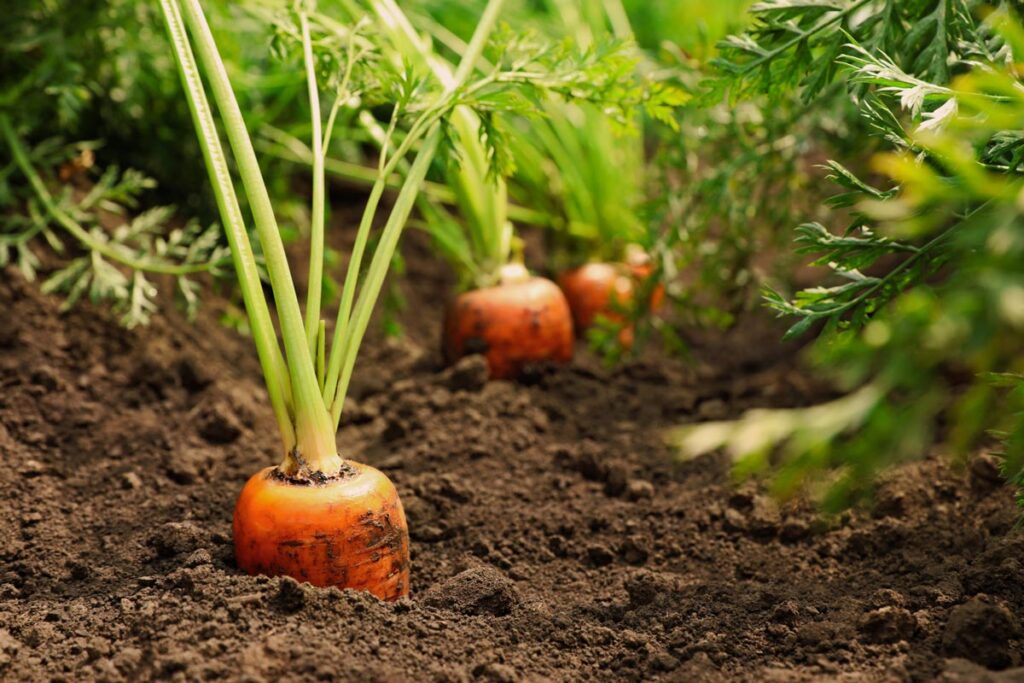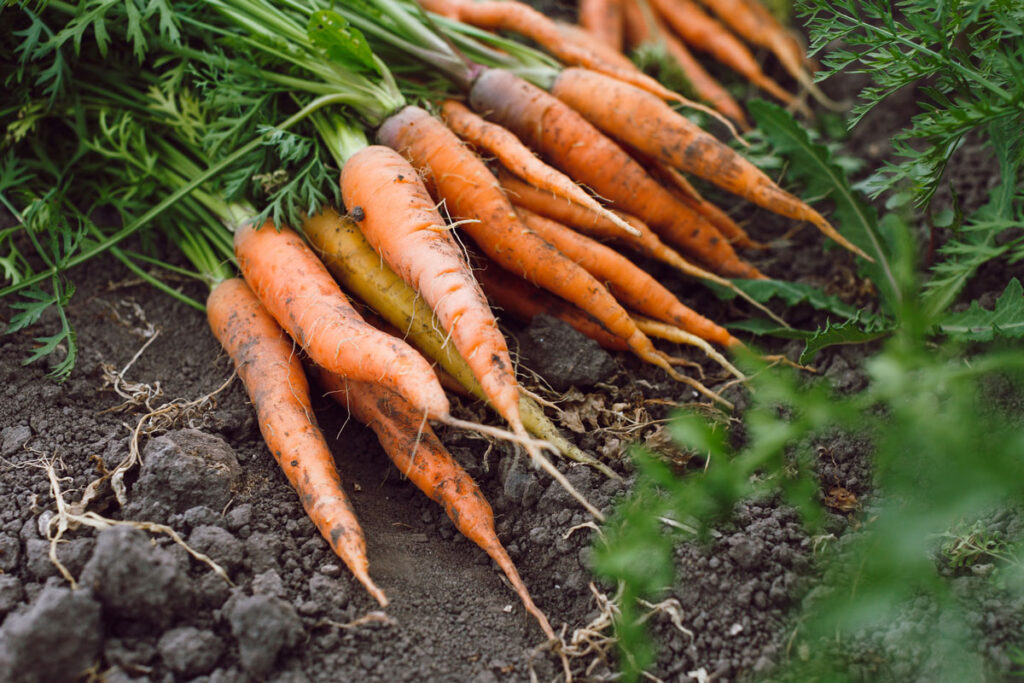Not everyone may feel as passionate as I do about growing root vegetables. I once wondered if growing root vegetables in spring and fall was worth it.

I didn’t know if I even liked to eat root vegetables. They grow underground, creating a need for patience in the process.
They are different in that you do not need to start seeds indoors. But, you will find that no fancy systems like hydroponics, aquaponics, a grow bag, or container gardens are needed.
Read on to learn best practices for growing root vegetables in soil and deeply appreciate them. You can and will have great success with growing and preparing delicious root vegetables. I encourage you to give it a try!
Why Grow Root Vegetables?
I used to be all about the fruit: beans, tomatoes, peppers, eggplant, and more. But, I was never much into root vegetables. I wasn’t sure that I liked to eat them and didn't like that I couldn’t see the growing process. I wasn’t sure if I wanted to spend my garden space on them.
Then I was given a gift of heirloom seeds late in the growing season. I was eager to get some of these seeds in the ground. I realized that I could plant radishes in September or October, and they would quickly come to maturity before winter.
That year I harvested a whole bunch of radishes. What do you do with a massive amount of radishes? Roast them! They are amazing!
Just quartered or halved, drizzled with olive oil, garlic, salt, and pepper, put into a 400° F oven, and roasted until the edges are slightly browned. This was a game changer when I realized how delicious root vegetables could be!
I quickly learned that root vegetables are delicious, quick to mature, and are a fantastic addition to your garden space. It’s no wonder they were included in my MUST grow garden list (heirloom seeds).

Benefits of Growing Root Vegetables
In addition to being nutrient-dense, root vegetables are multipurpose. You can eat the root as well as the plant in most cases. Take the turnip, many people grow them for their greens just as often as they grow them for their roots.
Root vegetables can withstand temperatures as low as 15° F, making them ideal for the fall garden (more tips on planting a fall garden here). With protection, root vegetables can continue to grow throughout the winter.
Having some sort of cover in your gardens like a cold frame or six mil plastic (available at any local garden center) will exponentially extend your root vegetables' life.
Pro-Tip: Fall and winter root vegetables will go into dormancy and take more time to reach maturity than indicated on the seed packets. This will depend on how much sunlight they will be getting. For best results, sow them in September or October so they can reach a certain point of maturity before the days begin getting much shorter in the winter months.

Tips for Growing Root Vegetables
Understanding the nature of root vegetables is the key to success. Here are a few tips I have learned along the way.
Temperature
Root vegetables prefer cooler temperatures. In the summer heat, the plant's energy is focused on growing the greens and setting off flowers, which in turn produce seeds.
But, in cooler temperatures, the plant focuses its energy on the roots, which makes for a sweeter, more delicious root.

Soil
Don’t grow your root vegetables in soil with too much nitrogen. If too much nitrogen is in the soil, you will have large leafy greens but small roots. Stick to using potassium or phosphorus-based fertilizers like blood meal or bone meal.
Make sure you plant in loose soil. If you have rocky or compacted soil, you will end up with funky-shaped roots that just don’t grow as well.
Pro-Tip: If you have clay soil, you can use large root vegetables like turnips to help improve the structure of your soil. Sow them in the fall, and do not harvest them. In the spring, till them back into the soil. This will allow the roots to break down into the soil, adding organic matter and air pockets.

Sowing Seeds
One seed equals one root. Because of this, root vegetables are not the best candidate for transplanting. They do best sown directly into your garden beds.
Proper spacing is imperative when planting. This may be difficult since the seeds are so small, so as the seedlings come up, be prepared to thin them out.
Thinning
Thinning root vegetable seedlings is important. Without thinning, you could have misshapen roots, roots the wrong size, or roots that have grown together.
To thin them without damaging other plants, do not pull up one of the seedlings. Instead, using scissors or your fingernails, pinch off one of the seedlings at the root, leaving the root that has already developed in the ground. Pulling up or damaging the desired roots is risky if you pull to thin the plants. Read here for more tips on how to separate seedlings.
Seed Saving
To save the seeds, leave root vegetables alone. If you harvest the roots or pick all the greens off of the plant, you are ending the plant-life essentially.
Allow the plant to live out the course of the plant life to harvest the seeds. Depending on the plant, you may need to leave them in the ground for two years. Carrots, for example, are biennial, meaning they will go to seed in their second year.

The Easiest Root Vegetables to Grow in your Garden
There are many wonderful root crops to grow like the turnip root or parsnips. However, I have enjoyed great success with radishes, carrots, and beets, with radishes being my first root love!
Growing Radishes
Radishes are easy to grow, quick to mature, and do not attract a lot of pests. This is a great vegetable for kids to grow for these same reasons.
Radishes can be roasted or mashed and used in place of potatoes in soups. Additionally, they can be used as a garnish in Mexican food like tacos. And, of course, they can be eaten raw or on salads to add that signature crisp, spicy kick.
You can also eat radish greens! Make a pesto, add to a salad, or roast them.
When to Grow Radishes
You do not have to worry about creating a frost-free environment for radishes. They actually have a sweeter flavor after they have been frost kissed, so they do significantly better in cooler temperatures. Try to plan your germination around your region’s projected frost date.
Check when the average first frost date is for your region, then look at the seed packet and count backward to know when to plant your seeds.
I sow my radishes to grow in fall/winter, starting in September or early October, when the days are still long enough to provide enough light for adequate growth, but the temperatures are cool enough for good root production.
Summer variety radishes can be planted in early spring and mature in 3-4 weeks.

Best Soil Conditions
Radishes grow best in loose, phosphorus, or potassium-rich soils. They do not do as well in nitrogen-rich soil. Perform a soil test to check your soil before sowing your seeds. Here are more tips on preparing and maintaining great soil.
Suggested Varieties
Radishes offer a beautiful assortment of colors to your garden and come in a wide variety beyond the pink and white salad varieties you find at the local grocery store.
An example is the Shite Daikon Radish. It has a mild flavor and is used in many Asian dishes. It is a large root vegetable well suited as a tillage crop.
Another option is the Spanish Black Radish with dark black skin contrasted with stark white insides (pictured above).
My favorite variety right now is the French Breakfast variety. There are also:
- Triton Purple Stems
- Plum Radishes
- Purple Radishes that come in different shapes and shades of purple
- Large red radish called China Rose
- White Icicle Radishes
- Heirloom varieties like Cherry Bell or Crimson Giant

Growing Carrots
Carrots are surprisingly difficult to grow for a vegetable that is so popular. This is mainly because carrots just will not grow when it is hot. They do much better in cooler weather. So, planting at the proper time will allow for success with this versatile vegetable.
Typically, carrots are eaten raw and are great for snacking. But, they are ideal for roasting and juicing, like in my easy green juice recipe.
Home-grown carrots offer a sweeter and more flavorful taste than their store-bought counterparts.
Carrots grace our tables in stir-fries, casseroles, salads, side dishes, and even as a pickled garnish. They add color and nutrients to our meals.
When to Grow Carrots
Carrots growing in cooler temperatures do better and also taste better. Carrots are a great spring or fall crop. Starting plants in September or October is optimal if you live in warm climates.
Carrots can withstand temperatures as low as 15° F, which allows them to winter over nicely. Read this in-depth tutorial for the best tips for planting and growing carrot seeds.
There are three flavor profiles for carrots: woody, pine or parsley, or sweet. If you are a carrot lover, then you probably like all of those flavor profiles.
These flavors are made up of a chemical compound in the carrot called terpenoids. Terpenoids combined with the sugars that the greens of the carrots produce gives the carrot its flavor.
The terpenoids are produced first and the sugars are produced as the carrot plant matures. So, the more they mature, the sweeter they become. If you harvest carrots too early, they may have a bitter flavor.
Leave them in the ground until they reach full maturity. This allows the roots to store the sugars that are created in the leaves through photosynthesis. You can even leave carrots in the ground and harvest them as needed throughout the winter. This will lend a sweeter flavor.
To overwinter carrots, just heap straw mulch on top of them until the greens are covered for added protection.
Pro-tip: If you decide to allow the carrots to winter over in the ground, mark the placement of the carrots to easily see their location once the tops die away in the cold.

Best Soil Conditions
Avoid nitrogen fertilizers as they cause the root to fork. Stick with phosphorus or potassium based fertilizers. Grow them in moist, well draining soil.
And as a side note, even watering is important as it prevents the carrot from cracking or splitting. Make sure you water regularly and do not let it experience periods of drought or over watering.
Suggested Varieties
If you like sweet carrots, Scarlet Nantes and Purple Dragon are my preferred recommendations. Purple Oxhearts are fun to grow for their unique shape (thick roots with a distinct heart shape).

Growing Beets
A disclaimer needs to be added here. Beets are one of the most misunderstood vegetables. They can be very delicious, however so many people have had bad experiences with beets. If that is you, I apologize, on behalf of vegetables everywhere. I hope you can look past your bad experience and give beets another go.
Beets are very, very good for you! They are one of the richest sources of phytonutrients of any vegetable. They have nutrient-rich roots and very versatile and delicious Swiss chard-like greens.
When you grow beets you get to harvest both the roots and the greens. This is a great use of your garden space.
Beets are best roasted, juiced, or pickled. When roasting them, splash them with vinegar to bring out the sugars. The vinegar breaks down the geosmin in the beets and breaks down the cell walls and releases the sugar allowing it to carmelize, creating a delicious sweet flavor.
When to Grow Beets
Again, beets love the cooler temperatures. They do well as a spring crop or a fall/winter crop. Many regions are able to produce two beet crops based on the projected freeze.
Also, beets actually develop the sugar in the roots first, so picking young beets will give you the sweeter flavor you may desire. This will also allow space for diversifying your garden or attempting that second planting.

Best Soil Conditions
Beets do well in loose, deep, and well-draining soils. Like with most root vegetables, the soil should not contain too much nitrogen. You can plant them in raised beds or in containers, just make sure they are not shallow beds.
Additionally, chill out on watering your beets! They actually concentrate their nutrients when they are dry. Subjecting beets to drought can make them a little more woody, but full of nutrients. This makes them a prime candidate for juicing!
Suggested Varieties
Beets can truly taste like dirt and there is a reason behind that. Beets actually have a chemical called geosmin in them.
Geosmin exists in the soil, which is released into the air by the soil. Geosmin is what you smell after it rains. It's the smell of the earth. And this is the exact same chemical that is found in beets. Beets truly taste like the earth.
Many people love this earthy flavor. If you don’t, then pay attention to the different varieties of beets. Some beets have less geosmin in their genetic make-up giving them less of an earthy flavor.
The Detroit Dark Red is one of the sweeter varieties of beets that contain less geosmin. If you love the earthy flavor of beets, the Chioggia Beet is the variety for you. It has three times more geosmin than the Detroit Dark Red.
I hope I have convinced you to give root vegetables a try in your garden! The good news is, you can try just a few of each root vegetable with the tips I've shared above and know if you'd like to try and get a second harvest in one growing season.
















